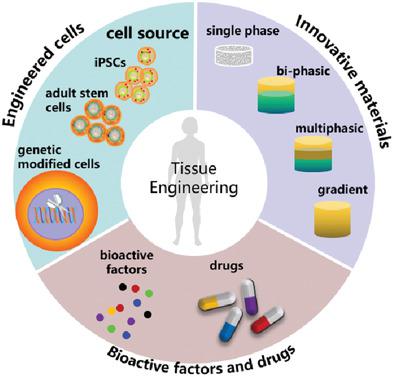当前位置:
X-MOL 学术
›
Adv. Healthcare Mater.
›
论文详情
Our official English website, www.x-mol.net, welcomes your
feedback! (Note: you will need to create a separate account there.)
Innovative Tissue‐Engineered Strategies for Osteochondral Defect Repair and Regeneration: Current Progress and Challenges
Advanced Healthcare Materials ( IF 10.0 ) Pub Date : 2020-10-26 , DOI: 10.1002/adhm.202001008 Liangbin Zhou 1 , Van Osch Gjvm 2, 3 , Jos Malda 4 , Martin J Stoddart 5 , Yuxiao Lai 6 , R Geoff Richards 5 , Kevin Ki-Wai Ho 1 , Ling Qin 1, 6
Advanced Healthcare Materials ( IF 10.0 ) Pub Date : 2020-10-26 , DOI: 10.1002/adhm.202001008 Liangbin Zhou 1 , Van Osch Gjvm 2, 3 , Jos Malda 4 , Martin J Stoddart 5 , Yuxiao Lai 6 , R Geoff Richards 5 , Kevin Ki-Wai Ho 1 , Ling Qin 1, 6
Affiliation

|
Clinical treatments for the repair of osteochondral defects (OCD) are merely palliative, not completely curative, and thus enormously unfulfilled challenges. With the in‐depth studies of biology, medicine, materials, and engineering technology, the conception of OCD repair and regeneration should be renewed. During the past decades, many innovative tissue‐engineered approaches for repairing and regenerating damaged osteochondral units have been widely explored. Various scaffold‐free and scaffold‐based strategies, such as monophasic, biphasic, and currently fabricated multiphasic and gradient architectures have been proposed and evaluated. Meanwhile, progenitor cells and tissue‐specific cells have also been intensively investigated in vivo as well as ex vivo. Concerning bioactive factors and drugs, they have been combined with scaffolds and/or living cells, and even released in a spatiotemporally controlled manner. Although tremendous progress has been achieved, further research and development (R&D) is needed to convert preclinical outcomes into clinical applications. Here, the osteochondral unit structure, its defect classifications, and diagnosis are summarized. Commonly used clinical reparative techniques, tissue‐engineered strategies, emerging 3D‐bioprinting technologies, and the status of their clinical applications are discussed. Existing challenges to translation are also discussed and potential solutions for future R&D directions are proposed.
中文翻译:

骨软骨缺损修复和再生的创新组织工程策略:当前进展和挑战
修复骨软骨缺损(OCD)的临床治疗只是姑息治疗,并非完全治愈,因此存在巨大的未解决的挑战。随着生物学、医学、材料、工程技术的深入研究,强迫症修复与再生的概念应予更新。在过去的几十年中,许多用于修复和再生受损骨软骨单位的创新组织工程方法已被广泛探索。已经提出并评估了各种无支架和基于支架的策略,例如单相、双相以及目前制造的多相和梯度结构。与此同时,祖细胞和组织特异性细胞也得到了体内和离体的深入研究。至于生物活性因子和药物,它们已与支架和/或活细胞结合,甚至以时空控制的方式释放。尽管已经取得了巨大进展,但仍需要进一步的研究和开发(R&D)以将临床前结果转化为临床应用。这里总结了骨软骨单位结构、其缺陷分类和诊断。讨论了常用的临床修复技术、组织工程策略、新兴的 3D 生物打印技术及其临床应用现状。还讨论了现有的翻译挑战,并提出了未来研发方向的潜在解决方案。
更新日期:2020-12-02
中文翻译:

骨软骨缺损修复和再生的创新组织工程策略:当前进展和挑战
修复骨软骨缺损(OCD)的临床治疗只是姑息治疗,并非完全治愈,因此存在巨大的未解决的挑战。随着生物学、医学、材料、工程技术的深入研究,强迫症修复与再生的概念应予更新。在过去的几十年中,许多用于修复和再生受损骨软骨单位的创新组织工程方法已被广泛探索。已经提出并评估了各种无支架和基于支架的策略,例如单相、双相以及目前制造的多相和梯度结构。与此同时,祖细胞和组织特异性细胞也得到了体内和离体的深入研究。至于生物活性因子和药物,它们已与支架和/或活细胞结合,甚至以时空控制的方式释放。尽管已经取得了巨大进展,但仍需要进一步的研究和开发(R&D)以将临床前结果转化为临床应用。这里总结了骨软骨单位结构、其缺陷分类和诊断。讨论了常用的临床修复技术、组织工程策略、新兴的 3D 生物打印技术及其临床应用现状。还讨论了现有的翻译挑战,并提出了未来研发方向的潜在解决方案。











































 京公网安备 11010802027423号
京公网安备 11010802027423号